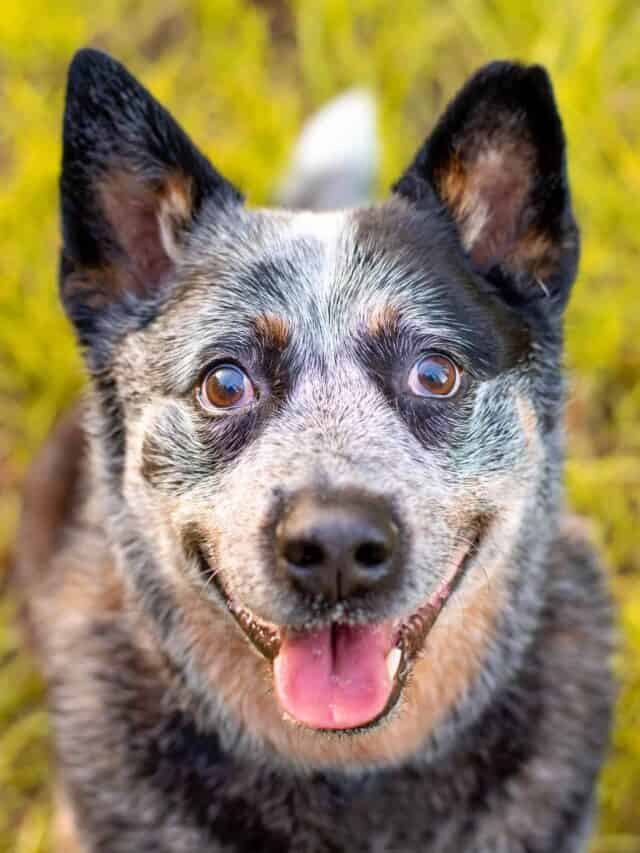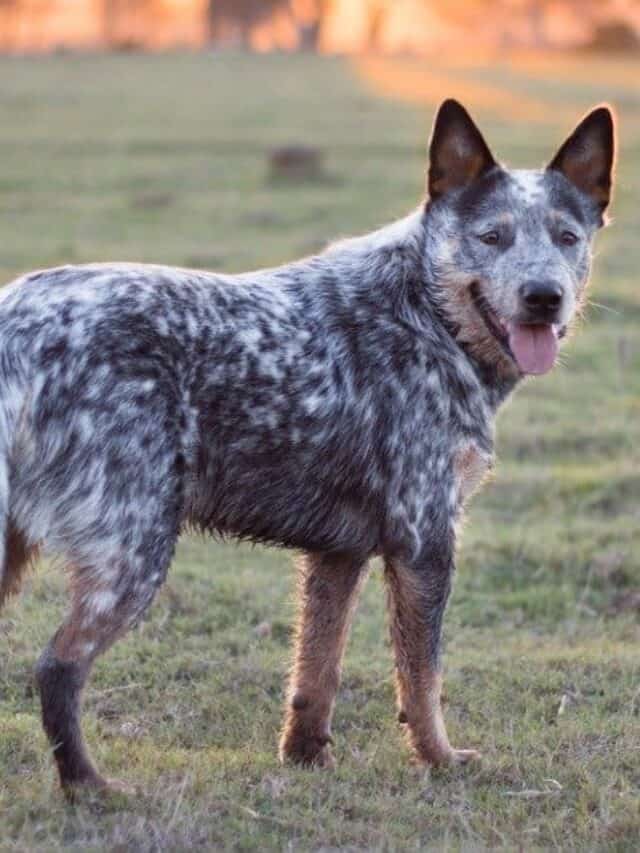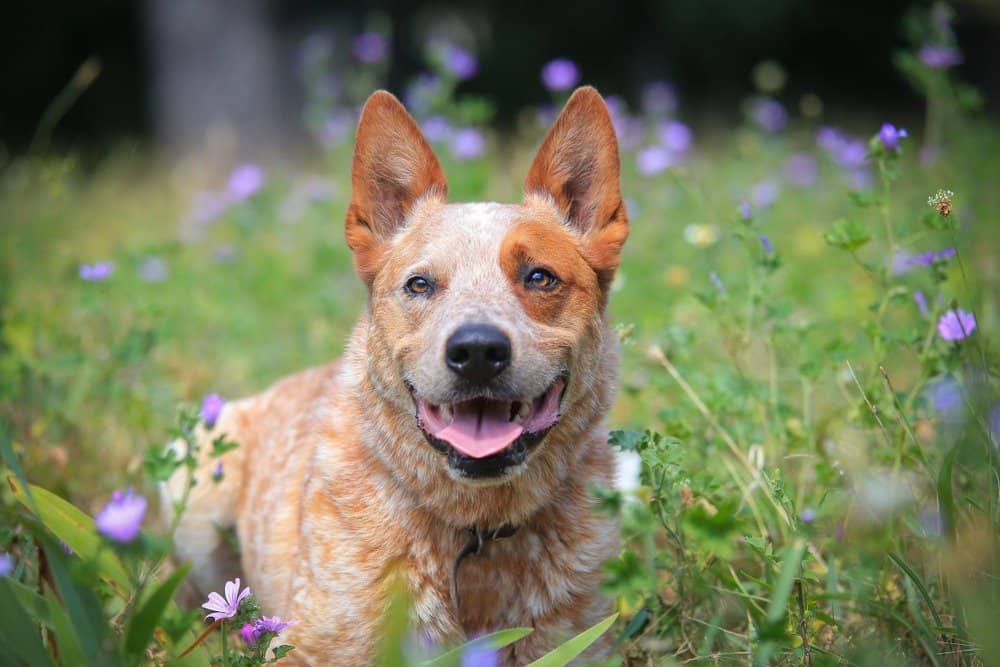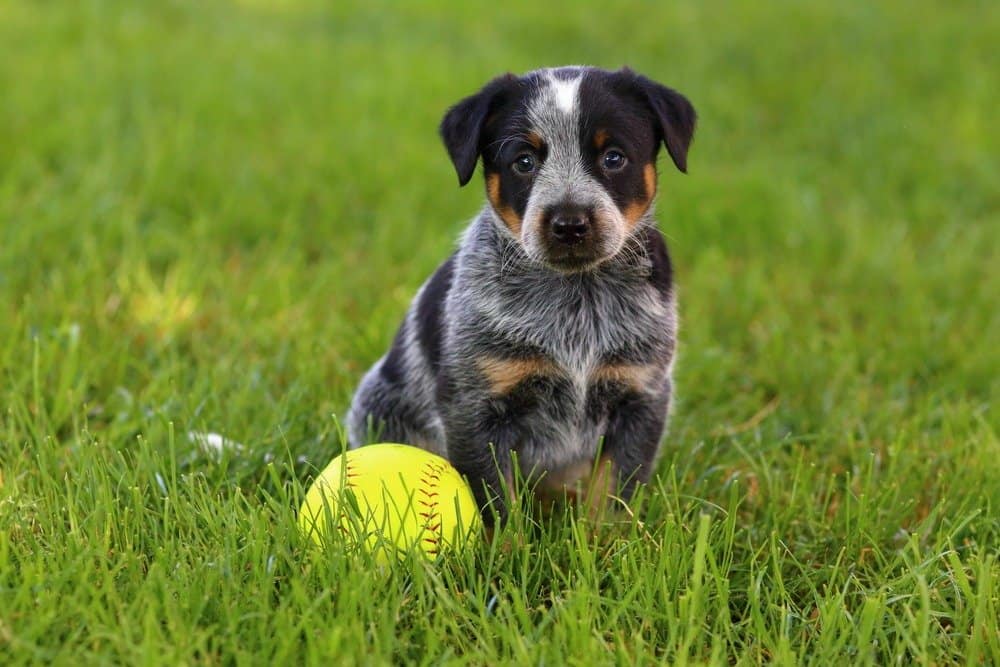Welcome to our comprehensive guide on blue heeler progression! As a proud owner of this unique and intelligent breed, you may be wondering what milestones your furry friend should reach different stages of their growth. In this article, we’ll provide you with a helpful growth chart that outlines the average weight and height of blue heelers from puppyhood to adulthood. Additionally, we’ll discuss important developmental milestones, such as when they will begin teething or become fully potty trained. Finally, we’ll offer valuable training tips for raising a well-behaved and socialized blue heeler companion. So whether you’re a first-time dog owner or an experienced handler looking for some expert advice, read on to discover everything you need to know about your beloved blue heeler’s progress!
Blue Heeler Summary

Blue heelers are also called Australian cattle dogs and Queensland heelers.
©iStock.com/Tatyana Consaul
The blue heeler, also known as the Australian cattle dog or Queensland heeler, is a unique and highly intelligent breed of working dog that was originally bred in Australia to help farmers manage herds of livestock. These dogs are medium-sized and muscular with short, dense coats that can be either blue or red in color. They have strong jaws and teeth perfect for nipping at the heels of unruly cattle.
Blue heelers are known for their high energy levels, loyalty to their owners, and natural herding instincts. They love to work hard but also enjoy spending time with their families as loyal companions. While they make excellent pets for active families who enjoy outdoor activities such as hiking or running, they may not be suitable for apartment living due to their need for regular exercise.
Training a blue heeler requires patience and consistency, as these dogs can be stubborn at times. Socialization is key during puppyhood to prevent potential aggression towards strangers or other animals later on in life. With proper training techniques, such as positive reinforcement methods and plenty of mental stimulation through interactive toys and puzzles, blue heelers can excel in obedience competitions and other canine sports.
Overall, the blue heeler is a highly versatile breed suited for both working roles on farms as well as loving family pets with an active lifestyle.
Blue Heeler Growth and Weight Chart by Age
| Age | Weight |
|---|---|
| 3 months | 12-15 pounds |
| 4 months | 15-18 pounds |
| 5 months | 20-24 pounds |
| 6 months | 23-26 pounds |
| 7 months | 25-29 pounds |
| 8 months | 26-30 pounds |
| 9 months | 27-31 pounds |
| 10 months | 28-33 pounds |
| 11 months | 29-34 pounds |
| 12 months | 30-35 pounds |
| 18 months | 30-45 pounds |
| 24 months | 30-50 pounds |
When Will My Blue Heeler Stop Growing?

The Australian cattle dog is also known as a blue heeler.
©iStock.com/Carmelka
Blue heelers are known for their high energy levels and strong work ethic, which is why it’s important to monitor their growth carefully. Typically, blue heeler puppies will continue to grow until they reach 12-18 months of age, when growth typically slows down or stops altogether.
To ensure your blue heeler is progressing at a healthy rate, it’s recommended that you provide them with the appropriate amount of food and water per day. On average, adult blue heelers should consume around 2-3 cups of quality dry dog food each day. It’s also important to make sure your dog has access to clean drinking water at all times.
Regular check-ups with a veterinarian can help ensure that your blue heeler is growing properly and staying healthy. It’s generally recommended that you take your pup in for an initial wellness visit within the first few weeks of ownership, followed by annual visits thereafter.
During these visits, the vet will be able to perform routine exams and screenings, such as weight checks and bloodwork, to detect any potential health issues early on. By taking proactive measures like this, you can help ensure that your beloved furry friend remains happy and healthy throughout their life!
How Big Will My Blue Heeler Be When It’s Fully Grown?

The Australian cattle dog weighs 30-50 pounds when fully grown.
©iStock.com/Madelein_Wolf
One of the most common questions that new blue heeler owners ask is how big their dog will be when it’s fully grown. While there are no set size standards for this breed, there are some general guidelines to keep in mind, when it comes to blue heeler progression.
On average, male blue heelers typically weigh between 35 and 50 pounds and stand around 17-20 inches tall at the shoulder. Female blue heelers tend to be slightly smaller, weighing in at around 30-45 pounds and standing about 16-19 inches tall.
However, genetics play a significant role in determining your dog’s final size. If your puppy comes from parents who were larger or smaller than average, they may not fit within these ranges.
Additionally, factors such as diet and exercise can also impact your dog’s growth rate and overall size. Providing them with a balanced diet rich in protein and nutrients while also ensuring they get plenty of exercise can help support healthy growth.
When Should My Blue Heeler Be Spayed or Neutered?
Spaying or neutering your blue heeler is an important decision that should be made in consultation with your veterinarian. While there are a variety of opinions regarding the optimal age for this procedure, most veterinarians recommend spaying or neutering between 6 and 12 months of age. This timeframe allows your pup to fully develop physically while also minimizing the risk of certain health issues, such as mammary tumors in females and testicular cancer in males.
Spaying or neutering may affect your blue heeler’s behavior and temperament. Spayed females may become less aggressive and more affectionate, while neutered males may exhibit calmer behavior and reduced territorial aggression. However, behavioral changes will vary depending on each individual dog.
When Should My Blue Heeler Be House Broken?

Blue heelers are not always blue. They can be white, gray, and tan as well.
©Melounix/Shutterstock.com
One of the most common questions that new blue heeler owners ask is when their puppy will be housebroken. The answer to this question can vary depending on several factors, including the age of the puppy, its temperament, and how consistent you are with your training efforts.
Typically, blue heelers can start being house-trained at around 8-12 weeks old. However, as with all parts of blue heeler progression, all puppies develop differently, and some may take longer than others to learn this skill.
To ensure successful potty training, consistency is key. Establishing a regular routine for feeding and potty breaks will help your blue heeler understand when it’s time to go outside. Be sure to praise and reward your pup every time they successfully use the designated potty area outside.
In addition to establishing a routine, crate training can also be helpful for housebreaking. When used correctly as part of a larger training plan, crates provide a safe space for puppies while also helping them learn bladder control.
Overall, patience and persistence are crucial when it comes to housebreaking any puppy, including blue heelers! With consistent effort from both you and your furry friend, success is within reach.
When Should My Blue Heeler Stop Eating Puppy Food?
As your blue heeler puppy grows, their nutritional needs will change. While puppy food is specially formulated to provide the essential nutrients for growth and development, it is important to transition them to adult dog food at the appropriate time. Generally speaking, between 9-12 months of age is a good time to make this switch.
However, it’s important to note that every dog is unique and may have different dietary requirements based on factors such as activity level and overall health. It’s always best to consult with your veterinarian before making any changes to your dog’s diet.
When transitioning from puppy food to adult food, it’s important not to do so too quickly or abruptly. Gradually mix in increasing amounts of adult dog food over a period of several days until your blue heeler has fully adjusted. This can help prevent digestive upset or other issues that may arise from sudden dietary changes.
When Will My Puppy Start Losing Teeth?

Puppies start losing their baby teeth around 3-4 months old.
©JLSnader/Shutterstock.com
Blue heeler puppies typically begin losing their baby teeth around three to four months of age. This process, also known as teething, can be uncomfortable for the puppy and may result in increased chewing behavior or even loss of appetite. As a responsible owner, it is important to monitor your pup’s teething progress and provide appropriate chew toys or treats to alleviate discomfort.
During this time, adult teeth will begin emerging and pushing out the baby teeth. This process can take several months and sometimes results in retained baby teeth that may need veterinary attention. Regular dental check-ups with a veterinarian are recommended during this period.
When Should I Start Training My Puppy?
Training your blue heeler puppy should begin as early as possible to establish good behavior and obedience. Ideally, training should start as soon as you bring your new furry friend home. This is the perfect time to teach basic commands. Blue heelers are known for their high energy levels, so it’s important to train them on leash walking and proper socialization with other dogs and people.
Puppyhood is a critical period for learning, so starting early will help prevent any unwanted behaviors from developing later on. Consistency in training methods is key, along with positive reinforcement techniques that reward good behavior rather than punishing bad behavior. It’s also recommended to enroll your blue heeler in puppy kindergarten classes or private training sessions with a professional dog trainer who has experience working with this breed.
Keep in mind that while puppies can learn quickly, they still have short attention spans and need frequent breaks during training sessions. Training sessions should be kept short (around 5-10 minutes) but done frequently throughout the day.
In summary, starting early with consistent positive reinforcement techniques will set your blue heeler up for success in its growth and development into a well-behaved adult dog.
What Cues Should I Teach My Puppy First?

Australian cattle dogs are a joy to train because they are so smart.
©WOLF AVNI/Shutterstock.com
As a blue heeler owner, there are certain cues that you should prioritize when it comes to training your pup. The first cue that you should focus on is the “sit” command. This is a simple yet essential cue that will help establish good behavior and obedience in your dog from an early age.
Once your blue heeler has mastered the sit command, you can move on to teaching them other basic commands such as “stay,” “come,” and “down.” These cues will help keep your dog safe and well-behaved in various situations.
Consistency is key when it comes to training your new puppy. Repetition and positive reinforcement are crucial for success. Additionally, using treats or rewards during training sessions can be highly effective in encouraging desired behaviors.
What Kind of Behavior Should I Expect From My Blue Heeler?
Blue heelers are characterized by high levels of energy and intelligence, both qualities that lend to their talent as excellent working dogs. These dogs are independent, but trainable, possessing the ability to learn new things and problem-solve. For your blue heeler to live its best life, it should get lots of exercise and mental stimulation. Great activities to make your dog happy could include canine sports, training, and challenging games.
While blue heelers can be affectionate and playful with owners and familiar family members, they are also reserved around strangers. This makes them a good choice for watchdogs if trained properly. Blue heelers have been known to nip at people’s heels, especially children, a behavior relating to their cattle-herding instincts. Through consistent training and a soft hand, these dogs can mature into well-mannered, mature pets.
The photo featured at the top of this post is © iStock.com/Tatyana Consaul
Ready to discover the top 10 cutest dog breeds in the entire world?
How about the fastest dogs, the largest dogs and those that are -- quite frankly -- just the kindest dogs on the planet? Each day, AZ Animals sends out lists just like this to our thousands of email subscribers. And the best part? It's FREE. Join today by entering your email below.
Thank you for reading! Have some feedback for us? Contact the AZ Animals editorial team.






